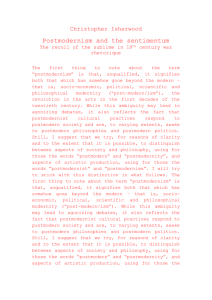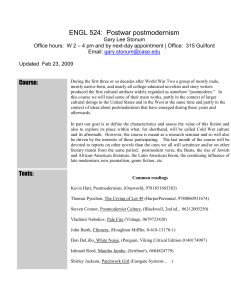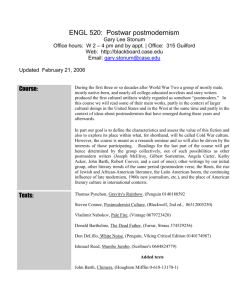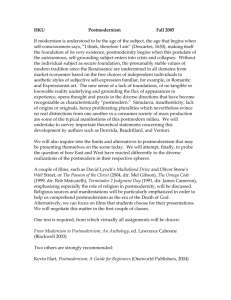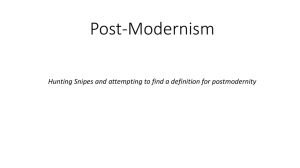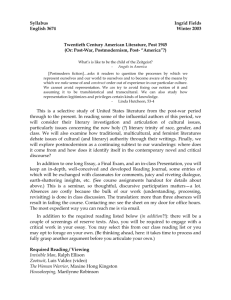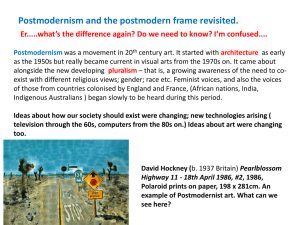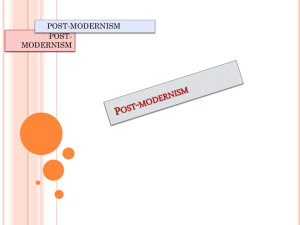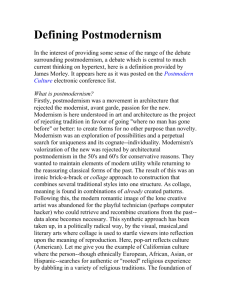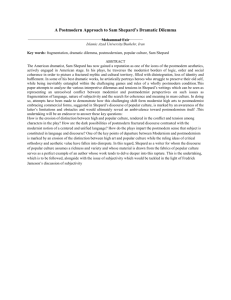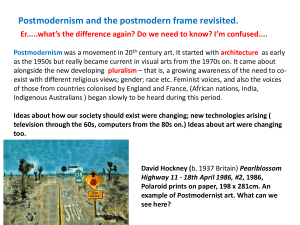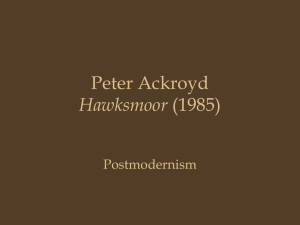Postmodernism
advertisement
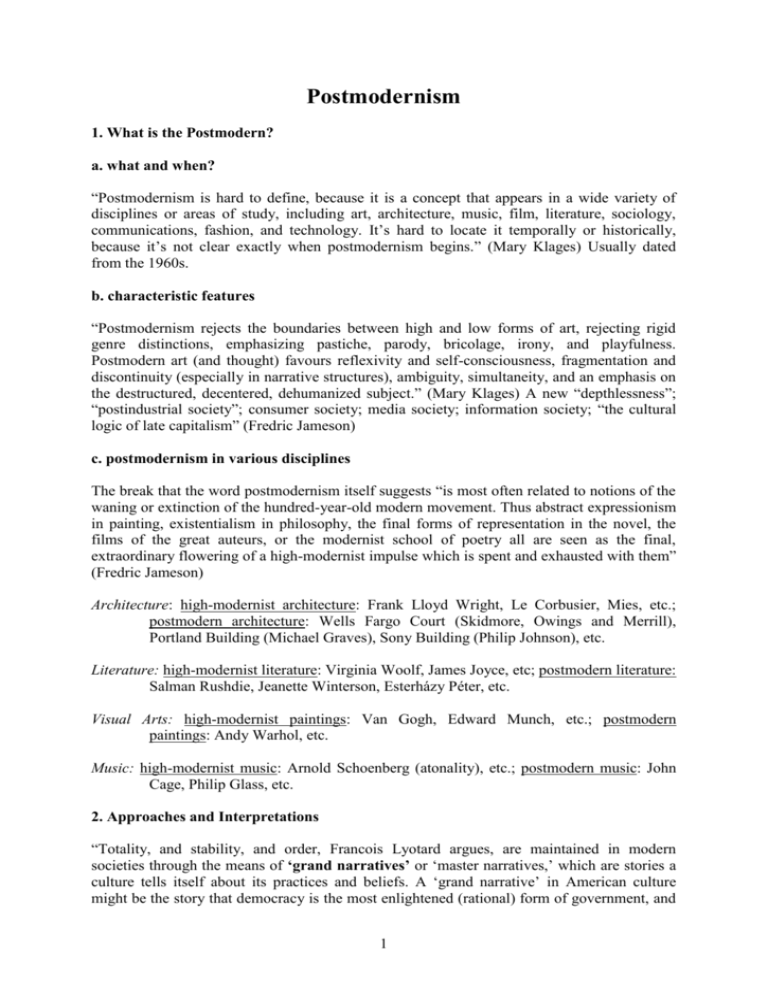
Postmodernism 1. What is the Postmodern? a. what and when? “Postmodernism is hard to define, because it is a concept that appears in a wide variety of disciplines or areas of study, including art, architecture, music, film, literature, sociology, communications, fashion, and technology. It’s hard to locate it temporally or historically, because it’s not clear exactly when postmodernism begins.” (Mary Klages) Usually dated from the 1960s. b. characteristic features “Postmodernism rejects the boundaries between high and low forms of art, rejecting rigid genre distinctions, emphasizing pastiche, parody, bricolage, irony, and playfulness. Postmodern art (and thought) favours reflexivity and self-consciousness, fragmentation and discontinuity (especially in narrative structures), ambiguity, simultaneity, and an emphasis on the destructured, decentered, dehumanized subject.” (Mary Klages) A new “depthlessness”; “postindustrial society”; consumer society; media society; information society; “the cultural logic of late capitalism” (Fredric Jameson) c. postmodernism in various disciplines The break that the word postmodernism itself suggests “is most often related to notions of the waning or extinction of the hundred-year-old modern movement. Thus abstract expressionism in painting, existentialism in philosophy, the final forms of representation in the novel, the films of the great auteurs, or the modernist school of poetry all are seen as the final, extraordinary flowering of a high-modernist impulse which is spent and exhausted with them” (Fredric Jameson) Architecture: high-modernist architecture: Frank Lloyd Wright, Le Corbusier, Mies, etc.; postmodern architecture: Wells Fargo Court (Skidmore, Owings and Merrill), Portland Building (Michael Graves), Sony Building (Philip Johnson), etc. Literature: high-modernist literature: Virginia Woolf, James Joyce, etc; postmodern literature: Salman Rushdie, Jeanette Winterson, Esterházy Péter, etc. Visual Arts: high-modernist paintings: Van Gogh, Edward Munch, etc.; postmodern paintings: Andy Warhol, etc. Music: high-modernist music: Arnold Schoenberg (atonality), etc.; postmodern music: John Cage, Philip Glass, etc. 2. Approaches and Interpretations “Totality, and stability, and order, Francois Lyotard argues, are maintained in modern societies through the means of ‘grand narratives’ or ‘master narratives,’ which are stories a culture tells itself about its practices and beliefs. A ‘grand narrative’ in American culture might be the story that democracy is the most enlightened (rational) form of government, and 1 that democracy can and will lead to universal human happiness. Every belief system or ideology has its grand narratives, according to Lyotard; for Marxism, for instance, the ‘grand narrative’ is the idea that capitalism will collapse in on itself and a utopian socialist world will evolve.” As opposed to grand narratives, “postmodern ‘mini-narratives’ are always situational, provisional, contingent, and temporary, making no claim to universality, truth, reason, or stability.” (Mary Klages) “Weakening of historicity?” (Fredric Jameson) Versus: Linda Hutcheon defines “historiographic metafiction” as a new postmodern genre that is “both intensely self-reflexive and yet paradoxically also lay[s] claim to historical events and personages.” The genre is characterized by the desire to be “accurately” historical as well as by the “theoretical selfawareness of history and fiction as human constructs” (Linda Hutcheon) “According to Jean Baudrillard in postmodern society there are no originals, only copies – or what he calls ‘simulacra.’ You might think, for example, about painting or sculpture, where there is an original work (by Van Gogh, for instance), and there might also be thousands of copies, but the original is the one with the highest value (particularly monetary value). Contrast that with cds or music recordings, where there is no ‘original,’ as in painting – no recording that is hung on a wall, or kept in a vault; rather, there are only copies, by the millions, that are all the same, and all sold for (approximately) the same amount of money. Another version of Baudrillard’s ‘simulacrum’ would be the concept of virtual reality, a reality created by simulation, for which there is no original. This is particularly evident in computer games/simulations – think of Sim City, Sim Ant, etc.” (Mary Klages) 3. Evaluating the postmodern “There are lots of questions to be asked about postmodernism, and one of the most important is about the politics involved--or, more simply, is this movement toward fragmentation, provisionality, performance, and instability something good or something bad? There are various answers to that; in our contemporary society, however, the desire to return to the prepostmodern era tends to get associated with conservative political, religious, and philosophical groups. In fact, one of the consequences of postmodernism seems to be the rise of religious fundamentalism, as a form of resistance to the questioning of the ‘grand narratives’ of religious truth. This is perhaps most obvious in Muslim fundamentalism in the Middle East, which ban postmodern books – like Salman Rushdie's The Satanic Verses – because they deconstruct such grand narratives.” (Mary Klages) “On another level, however, postmodernism seems to offer some alternatives to joining the global culture of consumption, where commodities and forms of knowledge are offered by forces far beyond any individual’s control. These alternatives focus on thinking of any and all action (or social struggle) as necessarily local, limited, and partial – but nonetheless effective. By discarding ‘grand narratives’ (like the liberation of the entire working class) and focusing on specific local goals (such as improved day care centers for working mothers in your own community), postmodernist politics offers a way to theorize local situations as fluid and unpredictable, though influenced by global trends.” (Mary Klages) 2
